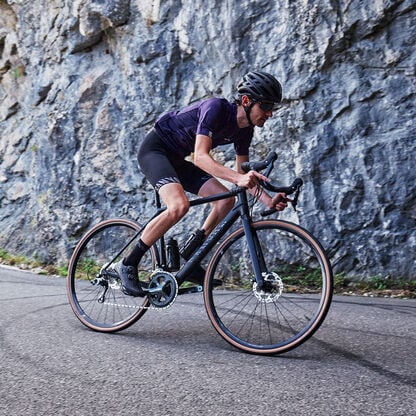Carbon vs aluminum road bikes: Why carbon is the clear choice today
The age-old carbon vs aluminum debate is back. Although aluminum has closed the gap, carbon still reigns supreme.


Buying a new road bike comes with a host of questions and considerations: How much should I spend? What road bike groupset should I choose? Mechanical or electric? A practically age-old question has been returning lately: Carbon or aluminum? Thanks to dramatic engineering advances over the last couple of decades, this question isn’t the slam dunk it once was, but carbon still holds significant advantages over its alloy rival.
Contents
Which frame material is better for a road bike: Carbon or aluminum?
When you pull up to your next group ride, you’ll notice most of the road bikes will be made of carbon fiber. There’s a reason for that. Although aluminum bikes were once strictly considered beginner bikes, some experienced riders do choose to go with aluminum. So how do you choose?
Aluminum bikes have never been lighter and more comfortable than today’s offerings. They also offer great durability and stiffness. But there’s a reason why carbon is the preferred material choice for most serious riders. Carbon’s stiffness-to-weight ratio is unmatched. Thanks to Canyon’s incredible engineering, carbon can be molded into the most aerodynamic shapes, allowing you to cheat the wind. You can also use additional carbon fiber to reinforce stress points, making the bike stronger, stiffer, and more responsive. Carbon’s vibration-damping properties absorb road noise, allowing you to ride longer or across rougher terrain. It’s simply the best material available for bikes.
Weight comparison: How carbon frames give you the edge
How much lighter is a carbon bike frame? Carbon road bikes will almost always weigh less than their aluminum siblings. If you explore the Endurace range, you'll notice clear differences in weight - so what’s behind that, and does it really matter on the road?
Carbon fiber has the best strength-to-weight ratio of any bike material. After years of designing and redesigning bikes, Canyon engineers have determined the ideal carbon layouts for bikes: where they need more carbon fiber to reinforce stress points and what areas they don’t need as much extra material.
Less material means less weight. Engineers don’t have as much freedom when designing aluminum bikes. Will those extra few grams matter on the road? Ask us when you’re climbing a massive hill or trying to bridge a gap during your next road race.
So, do carbon bikes make you faster? Yes, carbon bikes can make you faster because they’re lighter and stiffer, which improves power transfer and acceleration. Their aerodynamic designs also reduce drag, helping you maintain higher speeds with less effort
Ride feel and comfort: Why carbon improves your road experience
In most cases, frame geometry for carbon and aluminum road bikes will be very similar, if not identical. Comparing the aluminum Endurace 6 Raw and carbon Endurace CF 7, the aluminum bike has nearly identical numbers to its carbon sibling, save for the top tube length (553mm vs 543mm, size medium) and stand-over height (800mm vs 814mm, size medium).
Traditionally, aluminum bikes were considered much more uncomfortable versus carbon. The cheaper aluminum transferred the bumps and road imperfections into your contact points, basically your hands and butt, and in turn, your entire body. Unless you were riding pristine pavement, you felt like you’d gone 10 rounds with a prizefighter after a long ride.
Better grades of metal and joining techniques has allowed aluminum to reduce the comfort gap, but carbon still reigns. There’s a reason why the aluminum Endurace model uses a carbon fork and seatpost to help smooth out the ride: carbon will always be better at reducing road chatter and, in turn, rider fatigue.
Durability and repairability: What to expect from each material
Aluminum will take more abuse, which is why you see so many aluminum mountain bike offerings.
But because road cycling is less of a contact sport (usually) and carbon’s many attributes are necessary in racing or fast-paced rides, carbon typically wins out. Carbon fiber’s strength-to-weight ratio is unmatched and assuming the bike doesn’t suffer any major impacts, can theoretically be ridden indefinitely. If the carbon bike does suffer damage, it can be repaired by a professional, whereas aluminum typically can’t be repaired.
So, how fragile is a carbon road bike compared to aluminum? Carbon frames are generally lighter and stiffer than aluminum but can be more vulnerable to sharp impacts or crashes. Unlike aluminium, which tends to bend or dent on impact, carbon can crack or suffer hidden damage, making careful inspection important after any hard falls.
If you’re wondering, do carbon bikes crack easily? Generally, they don’t - carbon frames are built to be strong and durable for everyday riding.
How carbon delivers performance at a competitive price
Canyon Factory Racing (CFR bikes) use the highest-grade carbon fiber you can use for mass-production bikes. Each frame epitomizes Canyon’s world-class carbon engineering expertise: Thanks to specially placed reinforcement patches in the bike’s stress points, Canyon engineers have created some of the lightest, yet tough, race bikes in the world. These would be considered a quality level similar to Shimano Dura Ace, and you’ll likely find that groupset on many bikes at this level.
Next are the SLX branded bikes, which would be the equivalent of Ultegra. These road bikes use some of the world’s most advance carbon fiber, just a shade below the CFR level and a shade above the CF branded bikes, Canyon’s 105. Using three different levels of carbon fiber (and different groupsets) allows Canyon to hit price points palatable to nearly every rider.
Not sure which Canyon road bike fits your needs? Our road bike buying guide explains the differences between our CFR, SLX, and CF carbon levels, helping you choose the right bike based on performance, weight, and budget.
Why Canyon focuses on carbon fiber for road bikes
Few manufacturers devote the research and development that Canyon does. Canyon has spent years perfecting their carbon fiber bikes, continuously improving with each generation. Canyon wants their bikes to be the best, so they use the best materials, and right now, that’s carbon fiber.
This dedication is evident across our lineup – from the aerodynamic precision of the Aeroad, designed for cutting through the wind; to the lightweight efficiency of the Ultimate, built for climbing and all-around performance; and the Speedmax, engineered for time trial and triathlon dominance. Each model showcases our commitment to using advanced carbon technology to deliver speed, stiffness, and ride quality at the highest level.
Carbon vs. aluminum road bike: Which one is best for you?
The aluminum road bike will be cheaper, but the price difference between the aluminum and carbon bikes is fairly negligible, especially if you plan to ride most days over multiple years. The lifespan of both carbon and aluminum bikes depends largely on usage and maintenance, but generally, carbon frames can last indefinitely if they avoid major impacts, while aluminum frames may develop fatigue over time and eventually need replacement. Carbon can be repaired if damaged, whereas aluminum is harder to fix once cracked or bent.
If you travel with your bike a lot or race criteriums where crashing is a question of when rather than if, aluminum can be a viable option. But if you care about being the fastest one in a race or spirited group ride or want to be as comfortable as possible over longer distances, you should probably purchase a carbon fiber machine. (Just buy a good travel case if you decide to fly somewhere.)
For more detailed information on the specifications or if you have additional questions, be sure to check out our bike comparison tool. Just hit compare on the page, and you can choose up to two other bikes to analyze components, geometry, and more. If you’re new to road biking or looking for entry-level options, check out our beginner road bikes guide – it’s designed to help you find the perfect bike to start your journey.
Still can’t decide between the two models (and you can’t afford or have the garage space for both). Try taking them for a test ride at one of Canyon’s demo centers such as the one in Carlsbad, California and test ride centers in Europe. If after a few rides you feel like you’ve made the wrong decision, you can easily exchange it, thanks to Canyon’s generous 30-day return policy.
Discover our Road Bikes
Did this article help?
Thank you for your feedback
-
 About the author
About the authorRobert Annis
Robert Annis is an award-winning outdoor-travel journalist. As an experienced writer and sport enthusiast he writes content that is inspiring with focus on road biking. You might have read Robert's articles in Bicycling, National Geographic, Outside, Travel + Leisure, Inside Hook, AARP, Midwest Living, Sierra, Hemispheres, Departures, Lonely Planet, Afar, Los Angeles Times, Chicago Tribune, RV Magazine, and Hidden Compass.










